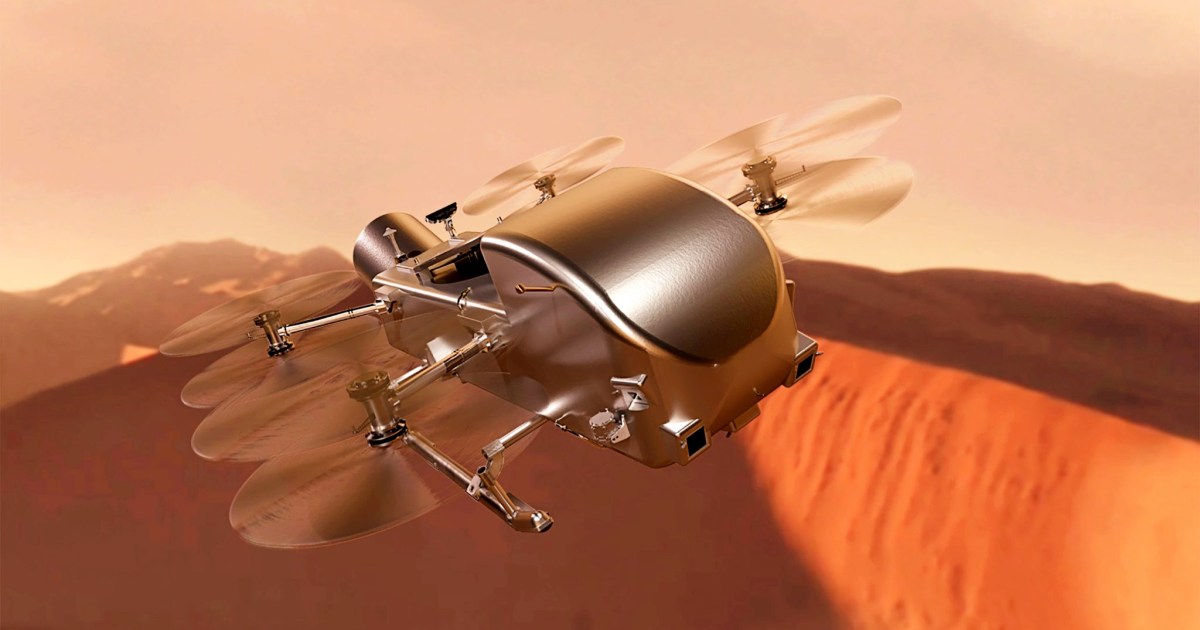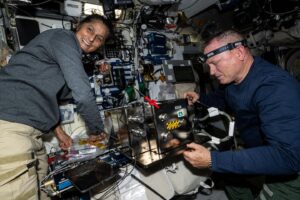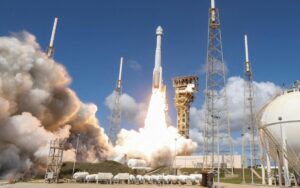There are many reasons to attend a scientific conference. You can see collaborators and friends pushing new projects. You can watch a lot of great talks that inform you about the latest great results in your research area. And then it happens, every once in a while, that you attend a big talk on a topic you know nothing about and come out reeling. That happened to me this week at the 2024 Astrobiology Conference (or AbSciCon), where I learned about NASA’s Dragonfly mission to Saturn’s giant moon Titan.
AbSciCon is a big conference. It takes place once every two years with multiple concurrent sessions taking place on all sorts of topics—everything from the origin of life to the nature of evolution to the physics of exoplanets. My colleagues and I had fun presenting a bunch of new research results. But what I love about this conference is the opportunity to learn so much about so many different fields. Most of the talks are short, 15-minute sessions that give you just a glimpse of the scientist’s work. However, the one-hour plenary talks in the morning really give you the opportunity to dive deep into a topic. Then my mind was blown by Dragonfly.
Exploring Titan
Let’s back up a bit so you can see what I’m talking about. Titan is the largest moon orbiting the gas giant Saturn. In fact, it is the second largest moon in the entire solar system. What really sets Titan apart, however, is that it is the only moon with a true atmosphere. Titan contains a thick layer of gas made mostly of nitrogen, but also with enough methane to make things interesting. The interaction of methane with sunlight makes Titan’s surface invisible under an opaque haze. In early 2000, NASA’s Cassini probe arrived at Saturn and spent a lot of time exploring Titan, including launching a probe on its surface. What planetary scientists discovered from these studies was that Titan may be the most interesting place in the Solar System after Earth when it comes to life.
Like many outer moons, Titan has vast amounts of water, including a subsurface ocean. The combination of so much water, methane, and other compounds results in remarkable behavior such as ethane/methane rain that collects in vast lakes of liquid methane. In fact, Titan is the only world that has liquids flowing steadily on its surface. Images of the Moon taken over time show evidence of a rich methane/ethane cycle of evaporation, rain, runoff, and collection into extended bodies such as lakes. However, Titan’s temperatures are quite low (-290) because Saturn is so far from the Sun. Despite these icebox conditions, there is so much interesting organic chemistry happening on Titan that scientists think it could be a great place to understand alternative biochemistry, ie. extraterrestrial life.
This is where Dragonfly comes in. The mission, approved by NASA in 2019, will send a quadcopter to Titan to explore the enigmatic moon. Yes, you read that right. We’re sending a flying lab to an alien, fog-covered moon that’s about 1 billion miles away. This is nothing but science fiction, but the mission is now advanced. It’s scheduled to launch in just four years, and should arrive on Titan in 2034. At this point, however, the technical challenges, the solutions NASA scientists are finding, and the possibilities of what Dragonfly will achieve are what have left the head I feel dizzy.
Dragonfly Challenges
The first problem NASA scientists face is control. After landing on the surface, the quadcopter will begin its exploration of Titan by flying a few kilometers and then staying there for about 16 days to take measurements. But Titan is so far from Earth that light signals take about an hour to make a one-way trip. This means that Dragonfly must do all of its actual flying without human supervision. It is an autonomous flying drone. Eh! Fortunately, NASA scientists have learned a lot about autonomous piloting from various Mars missions (including the remarkable Ingenuity Mars helicopter). Still, Dragonfly takes the issue of AI-directed aerial exploration to whole new levels.
The following are the science experiments collected in Dragonfly. The mission will measure everything from the chemical composition of Titan’s “soil” to climate conditions to seismographic surveys that may reveal details about Titan’s subsurface oceans. But all of Dragonfly’s complex experimental machinery must operate in both Titan’s low temperatures and relatively high atmospheric pressure. This presents a huge technical challenge that NASA engineers are working hard to solve.
The most startling thing for me was the size of the Dragonfly. For something that goes this far, that’s really big. The Dragonfly is about the size of a minivan (12.5 feet long, 5.5 feet tall) and weighs almost 1,900 pounds. It’s a large drone to send to another planet. Fortunately, thanks to Titan’s low gravity and thick atmosphere, it’s not difficult to get something as massive as a Dragonfly into the air.
During its three-year mission, scientists hope to use Dragonfly to explore more than 100 miles of Titan’s strange surface. It’s an extremely ambitious mission—and one to keep an eye on. Human beings can do many terrible things, and they can do many amazing things. Dragonfly falls into the latter category, and we should celebrate that.



